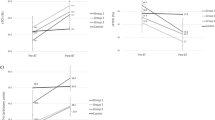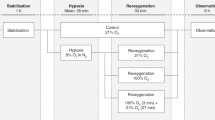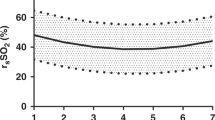Abstract
Objective:
The objective of this prospective, observational study was to test the hypothesis that tissue oxygenation in the splanchnic bed compared with tissue oxygenation in the cerebral circulation changes after feeding in preterm neonates who are tolerating full bolus orogastric feeds.
Study Design:
Clinically stable premature neonates with postmenstrual age between 32 and 356/7 weeks who were tolerating full bolus feedings were studied before feeding and 1 h after feeding using near-infrared spectroscopy. The ratio of oxygenated to reduced hemoglobin (tissue oxygenation index, TOI) in the splanchnic circulation bed was divided by the TOI in the cerebral circulation, thereby yielding the cerebro-splanchnic oxygenation ratio (CSOR). We compared TOI and CSOR before and after feeding. As the changes in TOI and CSOR had non-Gaussian distribution, nonparametric statistics were used.
Result:
Among 32 infants, CSOR increased significantly after feeding (median difference 0.08; range −0.48, +0.58; P=0.011), whereas pulse oximetry did not change significantly (P=0.600). The change in CSOR with feeding was associated with a significant increase in splanchnic TOI (preprandial median 43.8, range 25.2–68.4 vs postprandial 47.5, range 25.8–70.8; P=0.013), without any significant change in brain TOI (preprandial median 64.9, range 44.5–75.4 vs postprandial 58.9, range 42.2–72.3; P=0.153).
Conclusion:
This study indicates that CSOR and splanchnic TOI, but not brain TOI, increase significantly after feeding in stable preterm infants who are tolerating full orogastric feeds.
This is a preview of subscription content, access via your institution
Access options
Subscribe to this journal
Receive 12 print issues and online access
$259.00 per year
only $21.58 per issue
Buy this article
- Purchase on Springer Link
- Instant access to full article PDF
Prices may be subject to local taxes which are calculated during checkout
Similar content being viewed by others
References
Akinbi H, Abbasi S, Hilpert PL, Bhutani VK . Gastrointestinal and renal blood flow velocity profile in neonates with birth-asphyxia. J Pediatr 1994; 125: 625–627.
Quamar MI, Read AE, Skidmore R, Evans JH, Wells PNT . Transcutaneous Doppler ultrasound measurement of superior mesenteric artery blood flow in man. Gut 1986; 27: 100–104.
Weir FJ, Fong K, Ryan ML, Myhr T, Ohlsson A . Superior mesenteric artery and renal artery blood flow velocity measurements in neonates: technique and interobserver reliability. Pediatr Radiol 1995; 25: 145–148.
Martinussen M, Brubakk AM, Linker DT, Vik T, Yao AA . Mesenteric blood flow velocity and its relation to circulatory adaptation during the first week of life in healthy term infants. Pediatr Res 1994; 36: 334–339.
Leidig E . Doppler analysis of superior mesenteric artery blood flow in preterm infants. Arch Dis Child 1989; 64: 476–480.
Kempley ST, Gamsu HR . Superior mesenteric artery blood flow velocity in necrotising enterocolitis. Arch Dis Child 1992; 67: 793–796.
Kempley ST, Gamsu HR, Vyas S, Nicolaides K . Effects of intrauterine growth retardation on postnatal visceral and cerebral blood flow velocity. Arch Dis Child 1991; 66: 1115–1118.
Leidig E . Pulsed Doppler ultrasound blood flow measurements in the superior mesenteric artery of the newborn. Pediatr Radiol 1989; 19: 169–173.
Ozkan H, Oren H, Erdag N, Cevik N . Breast milk versus infant formulas: effects on intestinal blood flow in neonates. Indian J Pediatr 1994; 61: 703–709.
Hsu CH, Lee HC, Huang FY . Duplex ultrasonographic assessment of gut blood flow velocity: effect of meal composition in normal full-term newborns after first feed. J Ultrasound Med 1994; 13: 15–18.
Coombs RC, Morgan ME, Durbin GM, Booth IW, McNeish AS . Doppler assessment of human neonatal gut blood flow velocities: postnatal adaptation and response to feeds. J Pediatr Gastroenterol Nutr 1992; 15: 6–12.
Fang S, Kempley ST, Gamsu HR . Prediction of early tolerance to enteral feeding in preterm infants by measurement of superior mesenteric artery blood flow velocity. Arch Dis Child 2001; 85: F42–F45.
Lane AJP, Coombs RC, Evans DH, Levin RJ . Effect of feed interval and feed type on splanchnic hemodynamics. Arch Dis Child Fetal Neonatal Ed 1998; 79 (1): F49–F53.
Suzuki S, Takasaki S, Ozaki T, Kobayashi Y . A tissue oxygenation monitor using NIR spatially resolved spectroscopy. In: Chance B, Alfano RR, Tromberg BJ (eds). SPIE Proc (Optical Tomography and Spectroscopy of Tissue III, SPIE Digital Library, Bellingham, WA, USA) 1999; 3597: 582–592.
Petros AJ, Heys R, Tasker RC, Fortune PM, Roberts I, Kiely E . Near infrared spectroscopy can detect changes in splanchnic oxygen delivery in neonates during apnoeic episodes. Eur J Pediatr 1999; 158: 173–174.
Fortune PM, Wagstaff M, Petros AJ . Cerebro-splanchnic oxygenation ratio (CSOR) using near infrared spectroscopy may be able to predict splanchnic ischemia in neonates. Intensive Care Med 2001; 27: 1401–1407.
Petrova A, Mehta R . Near-infrared spectroscopy in the detection of regional tissue oxygenation during hypoxic events in preterm infants undergoing critical care. Pediatr Crit Care Med 2006; 7 (5): 449–454.
Underwood MA, Milstein JM, Sherman MP . Near-infrared spectroscopy as a screening tool for patent ductus arteriosus in extremely low birth weight infants. Neonatology 2007; 91 (2): 134–139.
Martinussen M, Brubakk A-M, Vik T, Yao AC . Mesenteric blood flow velocity and its relation to transitional circulatory adaptation in appropriate for gestational age preterm infants. Pediatr Res 1996; 39 (2): 275–280.
Teller J, Schwendener K, Wolf M, Keel M, Bucher HU, Fanconi S et al. Continuous monitoring of liver oxygenation with near infrared spectroscopy during naso-gastric tube feeding in neonates. Schweiz Med Wochenschr 2000; 130 (18): 652–656.
Coombs RC, Morgan ME, Durbin GM, Booth IW, McNeish AS . Abnormal gut blood flow velocities in neonates at risk of necrotizing enterocolitis. J Pediatr Gastr Nutr 1992; 15: 13–19.
Kempley ST, Gamsu HR . Superior mesenteric artery blood flow velocity in necrotizing enterocolitis. Arch Dis Child 1992; 67: 93–796.
Schwartzopff B, Hennersdorf M . Influence of cardiac circulation and medication on the perfusion of the intestine Zentralbl Chir. Zentralbl Chir 2005; 130 (3): 218–222.
Matcher SJ, Kirkpatrick P, Nahid K, Cope M, Delpy DT . Absolute quantification methods in tissue near infrared spectroscopy. Optical tomography, photon migration, and spectroscopy of tissue and model media: theory, human studies and instrumentation. Proc SPIE 1995; 2389: 486–495.
Havranek T, Madramootoo C, Carver J . Nasal continuous positive airway pressure affects pre- and postprandial intestinal blood flow in preterm infants. J Perinat 2007; 27 (11): 704–708.
Benders MJ, van Bel F, van de Bor M . The effect of phototherapy on cerebral blood flow velocity in preterm infants. Acta Paediatr 1998; 87 (7): 786–791.
Dani C, Bertini G, Martelli E, Pezzati M, Filippi L, Prussi C et al. Effects of phototherapy on cerebral haemodynamics in preterm infants: is fibre-optic different from conventional phototherapy? Dev Med Child Neurol 2004; 46 (2): 114–118.
Yanowitz TD, Yao AC, Pettigrew KD, Werner JC, Oh W, Stonestreet BS . Postnatal hemodynamic changes in very-low-birth weight infants. J Appl Physiol 1999; 87 (1): 370–380.
Kaufman J, Almodovar MC, Zuk J, Friesen RH . Correlation of abdominal site near infrared spectroscopy with gastric tonometry in infants following surgery for congenital heart disease. Pediatr Crit Care Med 2008; 9 (1): 62–68.
Meier SD, Eble BK, Stapleton GE, Morales DL, Chang AC, Andropoulos DB . Mesenteric oxyhemoglobin desaturation improves with patent ductus arteriosus ligation. J Perinatol 2006; 26 (9): 562–564.
Dorling J, Kempley S, Leaf A . Feeding growth restricted preterm infants with abnormal antenatal Doppler results. Arch Dis Child Fetal Neonatal Ed 2005; 90 (5): F359–F363.
Acknowledgements
Support for the study was provided from the Division of Neonatology, Children's Hospital at Montefiore, Bronx, NY, USA. Preliminary results were presented at the 2008 Eastern Society for Pediatric Research Annual Meeting, Philadelphia, PA, USA, 28–30 March 2008 and at the Annual Meeting of the PAS-SPR, Honolulu, Hawaii, 5 May 2008.
Author information
Authors and Affiliations
Corresponding author
Rights and permissions
About this article
Cite this article
Dave, V., Brion, L., Campbell, D. et al. Splanchnic tissue oxygenation, but not brain tissue oxygenation, increases after feeds in stable preterm neonates tolerating full bolus orogastric feeding. J Perinatol 29, 213–218 (2009). https://doi.org/10.1038/jp.2008.189
Received:
Revised:
Accepted:
Published:
Issue Date:
DOI: https://doi.org/10.1038/jp.2008.189
Keywords
This article is cited by
-
Abdominal Near Infrared Spectroscopy can be reliably used to measure splanchnic oxygenation changes in preterm infants
Journal of Perinatology (2023)
-
The effect of drip versus intermittent feeding on splanchnic oxygenation in preterm infants with intrauterine growth restriction: a prospective randomized trial
European Journal of Pediatrics (2023)
-
The effect of enteral bolus feeding on regional intestinal oxygen saturation in preterm infants is age-dependent: a longitudinal observational study
BMC Pediatrics (2019)
-
Feeding during transfusion and the risk of necrotizing enterocolitis in preterm infants
Journal of Perinatology (2019)
-
Splanchnic NIRS monitoring in neonatal care: rationale, current applications and future perspectives
Journal of Perinatology (2018)



